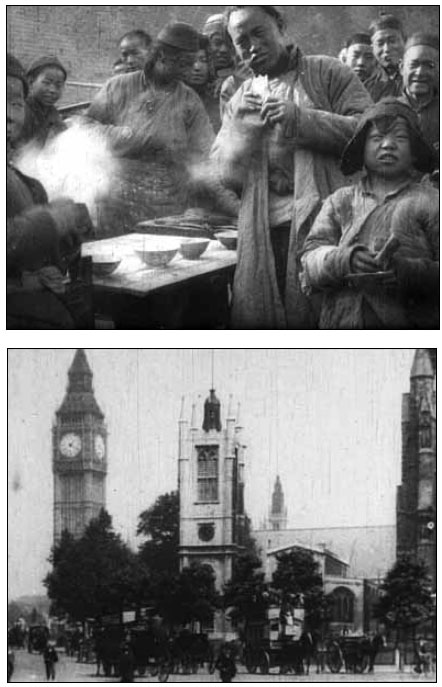Past perfect
Updated: 2012-05-04 11:11
By Chen Nan (China Daily)
|
|||||||||||
 |
|
The films made more than 80 years ago help audiences create a real connection with the past. Scenes from Peking and Its Environs (1910) (top) and Old London Street Scenes (1903) (above). Provided to China Daily |
 |
A series of films focusing on both Beijing and London, made from 1896 to 1939, reveal what's gone and what's come. Chen Nan reports.
In front of Beijing's Forbidden City is the city gate tower and tall trees. People wear black robes, and vendors are on the sides of the streets. It's a scene from 1900, screened in a 35-minute silent, black-and-white documentary.
Beijing reveals itself in 10 short films, part of Beijing-London Twin Cities, screened at Ullens Center For Contemporary Art (UCCA) in Beijing on April 28.
London, meanwhile, is revealed in 12 films - both complete and edited works - for a total of 22 rare silent films, made from 1896 to 1939. They include travelogues, short documentaries and home movies.
"I have shown the films of London a number of times in the United Kingdom, but this was the first time that anyone anywhere has seen the early films of China for more than 80 years," says Robin Baker, head curator at the BFI (British Film Institute) National Archive, who provided all the films.
Baker says both professional production companies and amateur filmmakers made the movies. His favorite is Modern China, also known as In Quaint Pekin! It was made in 1910 by the Charles Urban Trading Company, one of Britain's most important early film production companies.
At that time major British production companies sent filmmakers across the world to capture scenes that would then be shown back home.
He says the original film prints, stored by the BFI National Archive, are so fragile that it's impossible to project them, while the Beijing films have only recently been digitized.
"We really hope audiences in Beijing can enjoy seeing their city 80-100 years ago and marvel at both the similarities and the changes," says Xie Meng, a Beijing native and manager of UCCA's Education &Public Program.
The films reflect the perspective of whoever is behind the camera. It is interesting to contrast the home movies made by a Chinese family in 1932 with those of a British Methodist missionary in 1925.
"Both are, in fact, quite similar as you can see both filmmakers delighting in being in a beautiful city for the first time. They are both keen to capture the famous sights of Beijing on film - from the Summer Palace to Beihai Park," he says.
The curator visited Beijing once in 2010 and says it is fascinating to note the transformation. "The center of Beijing has clearly changed much more than that of London," he says.
The main thing that strikes the curator is that traffic is just as bad more than 100 years ago as it is today. A short film from 1903 called Old London Street Scenes shows the traffic, mainly horse-drawn omnibuses, to be chaotic and quite terrifying.
"Film is a great thing, which takes viewers from ancient times to the future," says Baker, who has worked as a film programmer and archivist for more than 20 years.
He says he loved film as a child, and the first movie he saw at a cinema was Chitty Chitty Bang Bang in 1968.
"I love the way that films such as these help audiences to create a real connection with the past - watching them is as likely as we're going to get to time travel."
The BFI is just beginning research into its collection of films about China, Baker says. As this research develops, he hopes to make these films of old Beijing available to audiences across the world.
Contact the writer at chennan@chinadaily.com.cn.
Today's Top News
Rescuers race against time for quake victims
Telecom workers restore links
Coal mine blast kills 18 in Jilin
Intl scholarship puts China on the map
More bird flu patients discharged
Gold loses sheen, but still a safe bet
US 'turns blind eye to human rights'
Telecom workers restore links
Hot Topics
Lunar probe , China growth forecasts, Emission rules get tougher, China seen through 'colored lens', International board,
Editor's Picks

|

|

|

|

|

|





